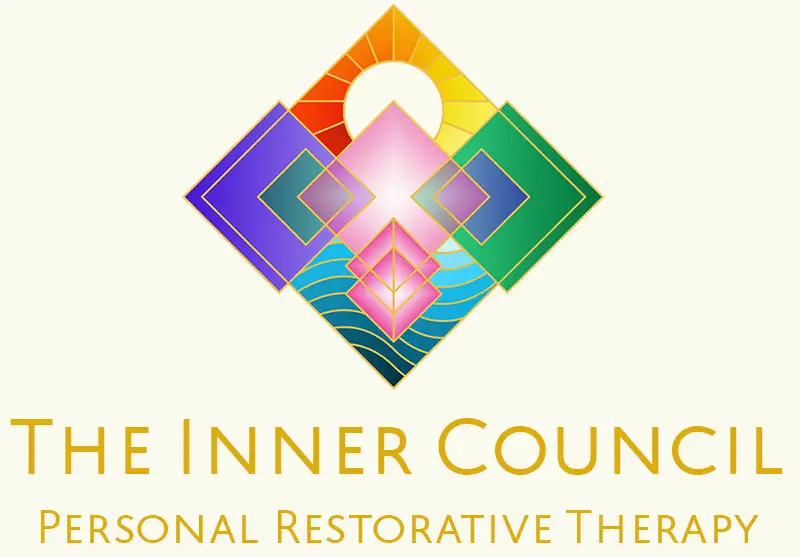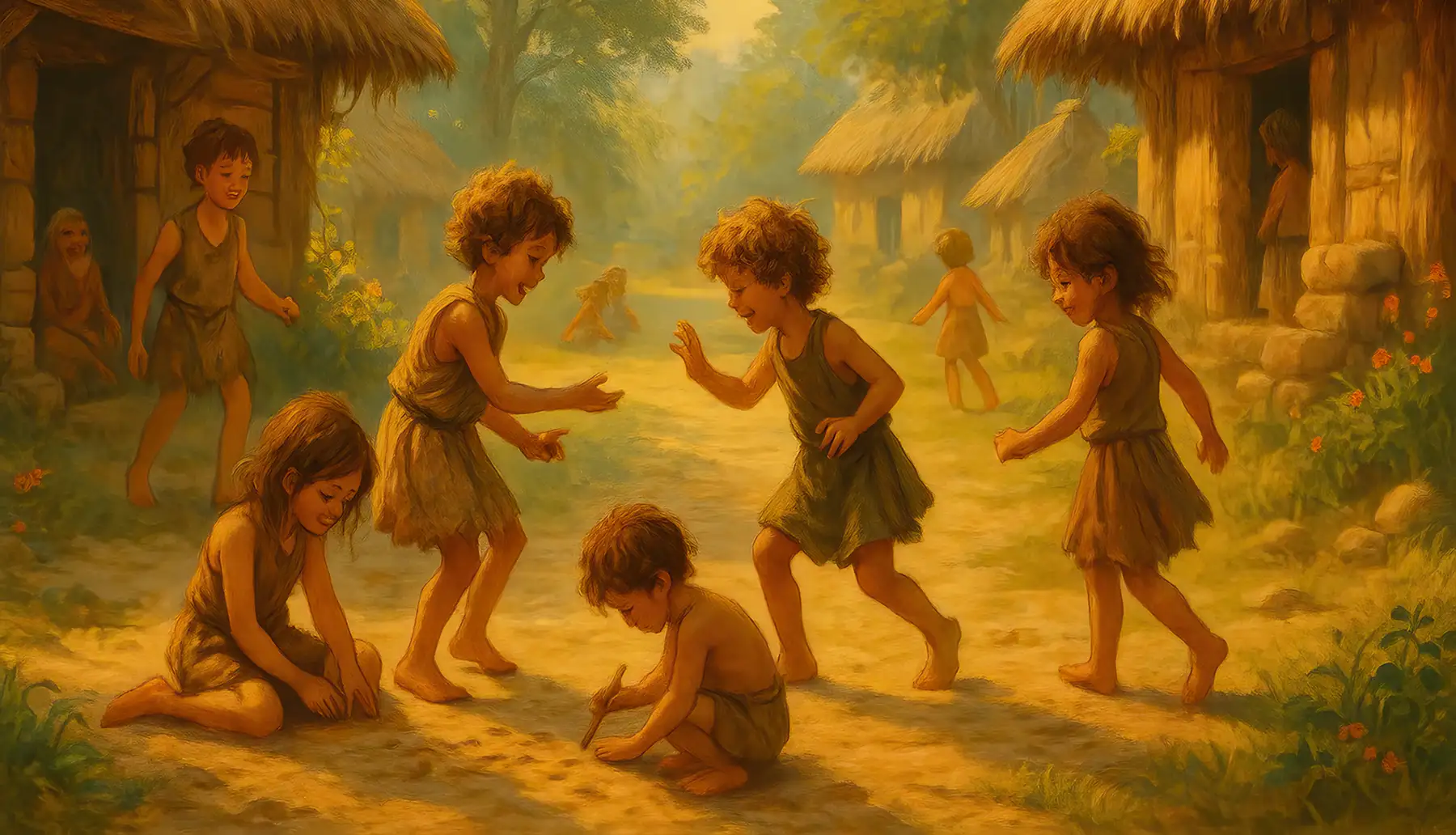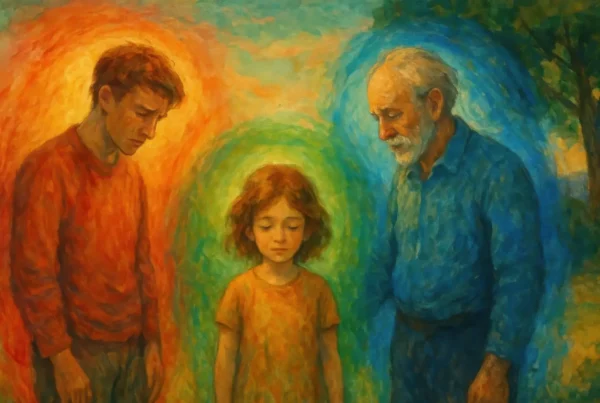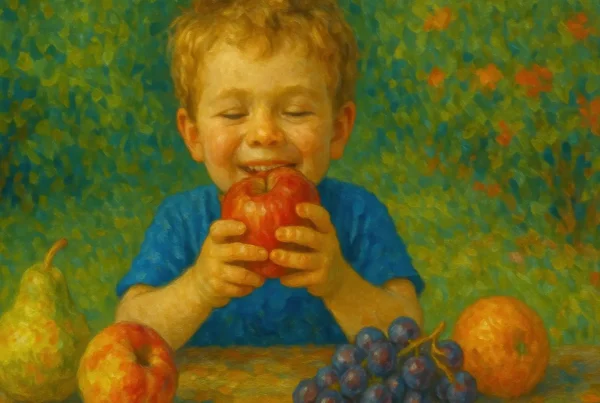BOOK YOUR WORKSHOP TODAY
All posts published here are presented as casual conversation pieces to provoke thought in some direction or another, they do not necessarily represent fixed opinions of the Inner Council, as our work exists beyond the spectrum of bound statement and singular clause.
A look at how play shaped human development in hunter-gatherer societies, and why restoring playful, non-coercive spaces is essential for inner child healing today.
Key Takeaways
- Play was the central mechanism through which hunter-gatherer children learned social, emotional, and cognitive skills.
- When play is free, self-directed, and communal, children develop empathy, cooperation, resilience, and inner safety.
- Modern restrictions on play contribute to anxiety, emotional rigidity, dominance patterns, and disconnection.
- The Inner Child heals through the same conditions that once shaped early human development: autonomy, imagination, warmth, and playful exploration.
- Reintroducing play recreates the psychological atmosphere of the “Inner Village,” allowing inner roles to relate rather than compete.
The Village That Played
For most of human history, children grew within a social world shaped not by strict rules or formal instruction, but by something far more organic: play. In hunter-gatherer societies, the longest-lived and most psychologically stable form of human culture, play was not a pastime but a governing principle. It was how children learned to navigate their environment, how adults maintained social harmony, and how the group as a whole protected itself from dominance and conflict.
In these cultures, play carried the same importance as food, shelter, ritual, and kinship. It was the atmosphere that held the group together, a continuous dance of curiosity, autonomy, responsiveness, humour, and creative negotiation. Children were trusted to explore, to take risks, to invent, to fail, and to try again, all within a social field that was warm, egalitarian, and flexible. Peter Gray, drawing on decades of cross-cultural research, suggests that play is not simply beneficial. It is evolutionary. It was selected because it produced adults who were cooperative, emotionally attuned, imaginative, and capable of living peacefully in community.
This insight carries enormous implications for the work of the Inner Council.
Play is not “childish”—it is the foundational intelligence through which the psyche becomes whole. It is the state in which the Inner Child feels safe enough to emerge, the Dreamer finds imagination, the Protector softens, the Analyst releases control, and the Inner Elder can guide rather than dominate. Play is the energy in which the Inner Village becomes possible.
Modern culture, however, has constricted this vital force. Where there was once freedom, there is now constant supervision. Where there was experimentation, there is now evaluation. Where there was unstructured time, there is now performance pressure. And where there was once a village that held children with warmth and spaciousness, there is now an institutional logic that narrows their world. The psychological consequences are visible—and profound.
To rebuild the Inner Village within ourselves, we must rediscover the same principle that once shaped families, communities, and childhoods across millennia:
to heal, to grow, and to reconnect, we must return to play.
Play as Evolution’s First Teacher
When we look closely at hunter-gatherer childhoods, a striking pattern emerges: children learned everything essential for adulthood through self-directed play. There were no adults hovering over them with tasks to complete or skills to master. Instead, adults created the conditions for children to explore without fear: physical safety, social inclusion, emotional warmth, and an absence of coercion. Learning was not something imposed—it was a spontaneous expression of curiosity.
Peter Gray describes this environment as an “educational system without teachers,” not because adults were absent, but because the world itself taught the child. Play allowed children to assimilate skills in the most natural way imaginable: by trying things, watching others, imitating, adjusting, and persistently experimenting. It was a continuous stream of self-regulated experience that refined motor coordination, emotional expression, interpersonal understanding, and cultural knowledge.
In this way, play acted as evolution’s first curriculum. It nurtured the capacities that mattered most for survival: cooperation, empathy, problem-solving, improvisation, and emotional regulation. These skills do not arise from instruction. They arise from lived experience—especially lived experience in which error carries no shame and exploration carries no penalty.
Within the Inner Council, this evolutionary truth becomes deeply personal. The Inner Child awakens not through analysis or self-improvement strategies, but through the same conditions that have always supported growth: freedom, curiosity, spontaneity, and safety. Modern adulthood encourages us to approach healing with linearity and control—yet the mind developed through openness and experimentation. To return to play is to return to the original mode of learning that shaped our humanity.
Play does something therapeutic that no amount of adult reasoning can replicate. It softens vigilance. It reanimates imagination. It reintroduces flexibility. It rebuilds trust in the body and in the world. When adults reconnect with play, even subtly, the psyche begins to reorganise itself—not through force, but through renewed aliveness.
In this sense, play is not merely a memory of childhood. It is the living architecture of human development—and the nervous system never forgets it.
Play as the Social Glue of the Village
If play was evolution’s first teacher, it was also evolution’s first form of social governance. Hunter-gatherer societies relied on play to maintain harmony, prevent dominance, and cultivate the emotional intelligence necessary for communal life. In these cultures, social order did not arise from authority or enforcement. It arose from a shared commitment to preserving a playful, flexible atmosphere in which relationships remained fluid, responsive, and egalitarian.
What made this possible was a remarkable cultural posture: the refusal to allow anyone to become too powerful. Peter Gray describes how hunter-gatherer groups deliberately softened ego through humour, teasing, and shared laughter. Play became a protective mechanism that kept pride, aggression, and hierarchy in check. When adults took themselves too seriously, the community responded with playful ridicule—not to shame, but to restore balance. The group functioned as a self-correcting emotional ecosystem.
Children were immersed in this communal field from birth. They saw adults negotiating differences lightly, repairing conflict quickly, and responding to stress with shared humour rather than escalation. They learned that emotional tension was not dangerous; it was simply another invitation for connection. Through play, children internalised the rhythm of cooperative living. They learned that relationships were maintained through sensitivity, flexibility, and reciprocity—not through force.
Play is uniquely suited for this role because it requires continual mutual adjustment. For a game to continue, every participant must monitor others’ feelings, desires, and signals. If one child becomes too aggressive, the game collapses. If one becomes too rigid, others lose interest. If someone feels excluded, the emotional fabric frays. To keep the game alive, each child becomes attuned to the social field. They learn empathy not as a moral expectation but as a practical necessity.
This is why Gray argues that play suppresses the dominance instinct. It trains children to prioritise connection over control. It builds the interpersonal sensitivity that allows groups to live together without hierarchy. In the absence of play, conflicts become rigid; in its presence, conflicts become negotiable. The village stays soft, relational, and emotionally porous.
When we translate this into the language of the Inner Village, the parallel is clear. The inner world becomes fragmented when one part tries to dominate the others—the inner critic, the anxious planner, the rigid protector. These parts, like individuals in a hierarchical society, operate from fear. They insist on control because they do not trust the relational field. But in an atmosphere of play, the internal hierarchy loosens. The Protector relaxes its vigilance. The Analyst softens its grip. The Inner Child feels welcomed rather than policed. The psyche becomes more like a community and less like an institution.
Play reintroduces flexibility where trauma has created rigidity. It restores responsiveness where fear has created defensiveness. It returns a sense of shared purpose where inner roles have become adversarial. Just as the hunter-gatherer village sustained harmony through a playful relational field, the Inner Village thrives when the psyche remembers how to relate without pressure or threat.
In this sense, play is not simply something the Inner Child does. It is the social intelligence of the whole psyche. It is the way the mind re-learns how to be in community with itself. And just as in ancient societies, the ability to live well together—internally or externally—depends on how well we remember the art of play.
The Loss of Play in Modern Culture and Why It Harms Children
If play once formed the developmental and social foundation of human life, then its disappearance in modern culture represents not just a change in childhood but a profound psychological rupture. Across a wide range of societies, Peter Gray observes an unmistakable pattern: as children’s opportunities for free, self-directed play diminish, rates of anxiety, depression, emotional dysregulation, and social conflict rise. The erosion of play is not simply unfortunate—it is destabilising at every level of development.
In hunter-gatherer societies, children spent most of their waking hours in unstructured play, often in multi-age groups, and with minimal adult interference. They navigated risk, conflict, and negotiation within a supportive social field, learning resilience through experience rather than instruction. Today’s children live in a fundamentally different environment, one shaped by constraints that are historically unprecedented: constant supervision, academic pressure, reduced peer autonomy, and a cultural fear of risk. Their world has become narrower, faster, and more externally controlled.
This shift has deep developmental consequences. When children are deprived of the chance to explore freely, they lose the opportunity to test their limits, recover from failure, and learn emotional self-regulation. Instead of discovering their own capacities through trial and error, they become dependent on external guidance and evaluation. The internal system that play is designed to build—confidence, flexibility, resilience—remains underdeveloped. The result is a form of emotional fragility that is mistakenly read as immaturity but is, in fact, an adaptation to a constricted environment.
A crucial element of Gray’s research is that hunter-gatherer adults rarely intervened in children’s disputes unless someone was in danger. Modern adults intervene constantly, often preventing children from learning the interpersonal skills that come from negotiating conflict themselves. Without these experiences, children become more sensitive to social stress and more reliant on adult authority to solve problems. Over time, this fosters an inner landscape in which self-trust diminishes and the capacity to hold emotional tension shrinks.
The decline of play is also linked to a rise in dominance behaviours—not just in children, but in adults. When play disappears, the natural mechanism that suppresses aggression and fosters mutual responsiveness is lost. Children who grow up in environments where everything is structured, monitored, and evaluated often learn that compliance, competition, or avoidance are the only available strategies. The relational intelligence that emerges through play—sensitivity, humour, negotiation—has no space to form.
In the Inner Council framework, this loss creates a predictable psychological pattern. When a person grows up without sufficient play, the internal system does not learn the flexible cooperation required for inner harmony. Instead, certain roles become exaggerated: the Protector becomes rigid or hypervigilant, the Analyst becomes controlling, the Inner Child becomes anxious or withdrawn. The psyche shifts toward internal authoritarianism because the ecological conditions that support internal collaboration were never nurtured.
This is why many adults feel disconnected from their own vitality, creativity, or capacity for joy. The adult self becomes shaped by the architecture of modern childhood: pressured, performative, monitored, and deprived of the spaciousness that play once offered. It is not simply that adults “forget how to play.” It is that their development unfolded in an environment where play was not permitted to do its evolutionary work.
The consequences radiate through the lifespan. Adults who lack the early experience of play often struggle with spontaneity, relational ease, emotional resilience, and the ability to tolerate uncertainty. These are not character flaws; they are developmental absences. Gray’s research makes it clear that play is not something children outgrow—it is something the human organism requires to develop fully.
And when play is missing, the psyche remembers. It remembers through anxiety, through perfectionism, through inner conflict, through rigidity, through the aching sense that life has become effort rather than exploration.
This is why restoring play is not simply an intervention for children—it is a pathway for adults to rebuild the psychological structures that modern culture failed to nourish. In the Inner Village, reintroducing play is not nostalgia. It is repair.
Play and the Inner Child
If modern life has constricted the role of play in children’s development, the adult psyche carries the consequences. Many of the difficulties adults experience—emotional rigidity, chronic self-criticism, loss of imagination, relational anxiety—can be traced back to environments where play was limited, controlled, or devalued. The Inner Child, whose natural developmental language is play, becomes one of the most significant casualties of this cultural shift.
In the Inner Council framework, the Inner Child is not a metaphor. She is the living imprint of early developmental layers—the part of the psyche that still feels, responds, learns, and interprets the world through sensory experience, imagination, and relational safety. Her world is not logical but intuitive; not structured but fluid; not task-driven but exploratory. She understands life through sensation, rhythm, story, and relationship. And she becomes accessible only in an atmosphere of play.
This is why adult attempts to engage the Inner Child through analysis or explanation so often fall short. Rational insight belongs to a later developmental stage, one that cannot translate the emotional language of the earliest years. The Inner Child responds not to intellectual clarity but to tone, approach, and atmosphere. She retreats when pressured, silences herself when judged, and hides when faced with internal authority. But she comes forward when the inner environment becomes spacious, curious, and warm—when it feels like play.
Play is the Inner Child’s natural mode of expression. It is the state in which she feels safe enough to explore her feelings, reveal her wounds, and rediscover parts of herself that were muted or suppressed. When adults re-enter a playful state, even subtly, they create a bridge between their adult consciousness and the child’s experiential world. This bridge is not symbolic—it is neurological. The nervous system relaxes. Imagination reawakens. The fight-and-flight reflex softens. The body becomes a place where the child can return.
The healing potential of play lies in its non-coercive nature. In hunter-gatherer societies, play flourished precisely because adults did not impose it or shape it. The same principle applies internally. The Inner Child cannot be forced to heal. She cannot be commanded to reveal her story or expected to trust on demand. She moves at her own pace, guided by safety rather than pressure. Play invites her rather than pushes her. It opens a door rather than demands a disclosure.
When adults reconnect with play—whether through creativity, movement, humour, drawing, exploring nature, or simply softening the inner tone—the Inner Child receives a signal she has long been waiting for:
It is safe now. You are not being evaluated. You are not being controlled. You are not being rushed. You can be yourself.
- This shifts the entire psychology.
- The inner atmosphere becomes gentler.
- The rigid parts relax their grip.
- The harsh inner voices lose their authority.
- Imagination returns.
- Emotion becomes less threatening.
In this sense, play is not a regression to immaturity but a return to the developmental pathway that was interrupted. It allows the Inner Child to complete what she could not complete then—to express what she could not express, to feel what was too overwhelming, and to integrate experiences that were never properly digested.
More importantly, play reinstates the sense of relational warmth that children require to grow. It restores the emotional oxygen that disappears when the psyche becomes dominated by fear or control. Through play, adults rediscover a mode of being that is less about performance and more about presence. This is the beginning of inner safety. And inner safety is the beginning of inner healing.
To reconnect with play is to reconnect with the part of ourselves that remembers how to belong—to ourselves, to others, and to the deeper currents of life that move beneath the surface of reasoning.
In this way, the Inner Child is not healed through play.
She becomes free to heal because play has returned.
Play and the Inner Village
If the Inner Child is awakened through play, then the Inner Village is sustained by it. In community psychology, play is not simply a developmental activity—it is a social technology. It is how human groups historically maintained emotional warmth, regulated conflict, prevented dominance, and created shared meaning. When translated into the inner world, this becomes a powerful insight: play is not only how we heal internally, but how the inner community—the Council, the Village—learns to live together.
The Inner Village represents the total ecology of the psyche: the Child, the Dreamer, the Protector, the Analyst, the Witness, the Elder, and the many subtle roles that form the architecture of inner life. Each of these parts carries its own temperament, history, and epistemology. Without a cohesive relational atmosphere, these roles often fall into competition or rigid positions—mirroring the dynamics of societies where play is absent.
Play introduces the relational conditions under which the Inner Village can thrive. It loosens the internal hierarchies that become entrenched when fear, trauma, or shame predominates. It allows rigid roles to soften and become curious again. The Protector no longer clamps down with hypervigilance; the Analyst no longer insists on control; the Critic loses its authority; the Child no longer hides; the Elder becomes more accessible. In this softening, the psyche begins to function less like a set of competing agendas and more like a living community.
What allows this transformation is the nature of play itself. Play requires sensitivity to context, responsiveness to others, and openness to improvisation. It creates an environment where emotional tension is not a threat but an opportunity for reconnection. Hunter-gatherer groups understood this implicitly: when play was present, the group felt safe. Humor, mimicry, and shared activity diffused conflict before it escalated. Adults and children alike participated in maintaining a gentle social equilibrium that protected the group from authoritarian impulses.
Internally, play performs the same function. It reduces the emotional “charge” around difficult inner material. It lowers the stakes so that inner roles can express themselves without fear of punishment or scrutiny. It creates a climate where exploration is possible, where mistakes do not carry the weight of failure, and where feelings can move freely without being pathologised. The psyche becomes less hierarchical, less punitive, and more relational.
Play also reactivates imagination—an essential ingredient for Inner Village work. The Dreamer uses imagination to create new possibilities; the Child uses it to communicate emotional truths; the Protector uses it to visualise safety; the Elder uses it to illuminate inner wisdom. When imagination is alive, the inner world becomes a place where dialogue is possible. Without imagination, inner work becomes rigid, literal, and procedural. Play returns fluidity to the imagination and thereby reopens pathways to healing.
There is another dimension to consider: play deepens belonging. In hunter-gatherer societies, belonging was not enforced; it was co-created through shared activity. Children were not “taught” how to belong—they played themselves into belonging. The same is true internally. When adults reconnect with playful states, a sense of inner belonging begins to emerge. The parts of the psyche that once felt isolated or adversarial begin to recognise themselves as members of a larger whole.
In this sense, play becomes a form of inner governance. It creates the conditions for mutual respect among inner roles. It replicates the psychological atmosphere of the village: warm, egalitarian, humourful, adaptive. The psyche becomes a place where each voice can be heard without fear of reprisal, where no part needs to dominate, and where the collective can self-organise around connection rather than conflict.
Play is the social intelligence of the inner world.
It is the common language through which the Village communicates.
And when play is allowed to return, the Village becomes not only functional but alive.
To Heal, We Must Play Again
Peter Gray’s work reveals something that modern life has largely obscured: play is not an accessory to human development; it is its architecture. It is the original language of the child, the first curriculum of the tribe, the social intelligence of the village, and the ecological condition in which emotional life becomes safe, expressive, and resilient. Play built us. When it fades, the structures of human flourishing weaken.
In a culture that values productivity, certainty, and performance, the loss of play feels almost invisible. It disappears quietly under schedules, screens, academic pressure, and the relentless busyness of adult life. But the consequences are etched into the psyche. When play recedes, inner life becomes brittle: roles harden, creativity dims, and the capacity for emotional flexibility narrows. The Inner Child withdraws, the Dreamer quiets, the Protector tenses, and the Analyst overreaches. The Inner Village loses the warmth and spaciousness it needs to function.
The inverse is also true. The moment play begins to return—even gently, even subtly—the psyche starts to breathe again. The nervous system softens. Imagination reawakens. Relationship to self becomes less adversarial and more curious. Parts that once felt isolated begin to recognise one another. The inner community re-forms around shared presence rather than internal conflict.
In this way, the path forward is not mysterious. It is ancient. Hunter-gatherer societies understood that a harmonious group must cultivate an atmosphere of play: a place where autonomy is respected, laughter is shared, conflict is softened, and meaning arises organically through shared experience. To rebuild the Inner Village, we must reintroduce the same qualities inside ourselves.
To heal is not simply to understand what hurt us. It is to re-enter the mode of being in which healing becomes possible: playfulness, openness, experimentation, warmth, and relational safety. These are not therapeutic techniques. They are the evolutionary conditions for psychological integration.
And so the work of healing is the work of remembering.
- Remembering how to explore without fear.
- Remembering how to imagine without judgment.
- Remembering how to relate without armour.
- Remembering how to soften our internal hierarchies.
- Remembering how to trust curiosity again.
The Inner Village thrives when we allow the playful energies of the psyche to come alive, not as entertainment but as the natural intelligence that makes human community—inner and outer—possible.
- To heal, we must return to what built us.
- To heal, we must return to play.
Please download Play as a Foundation for Hunter- Gatherer Social Existence by Peter Gray.
And visit our Inner Child Workshop page for more information.
Suggested Reading
- Peter Gray — Free to Learn
A comprehensive look at the importance of self-directed play in children’s development and emotional wellbeing. - Stuart Brown — Play: How It Shapes the Brain, Opens the Imagination, and Invigorates the Soul
A scientific and humanistic exploration of play across the lifespan. - Brian Sutton-Smith — The Ambiguity of Play
A seminal text on the cultural and psychological functions of play. - Barry Hewlett & Bonnie Hewlett — Hunter-Gatherer Childhoods
Anthropological research showing how autonomy, play, and alloparenting shape resilient, emotionally secure children. - James Suzman — Affluence Without Abundance
A modern account of the Ju/’hoansi that highlights egalitarian culture, social harmony, and children’s autonomy. - Darcia Narvaez — Neurobiology and the Development of Human Morality
Examines how early ancestral caregiving practices formed the evolutionary foundations of human empathy.





